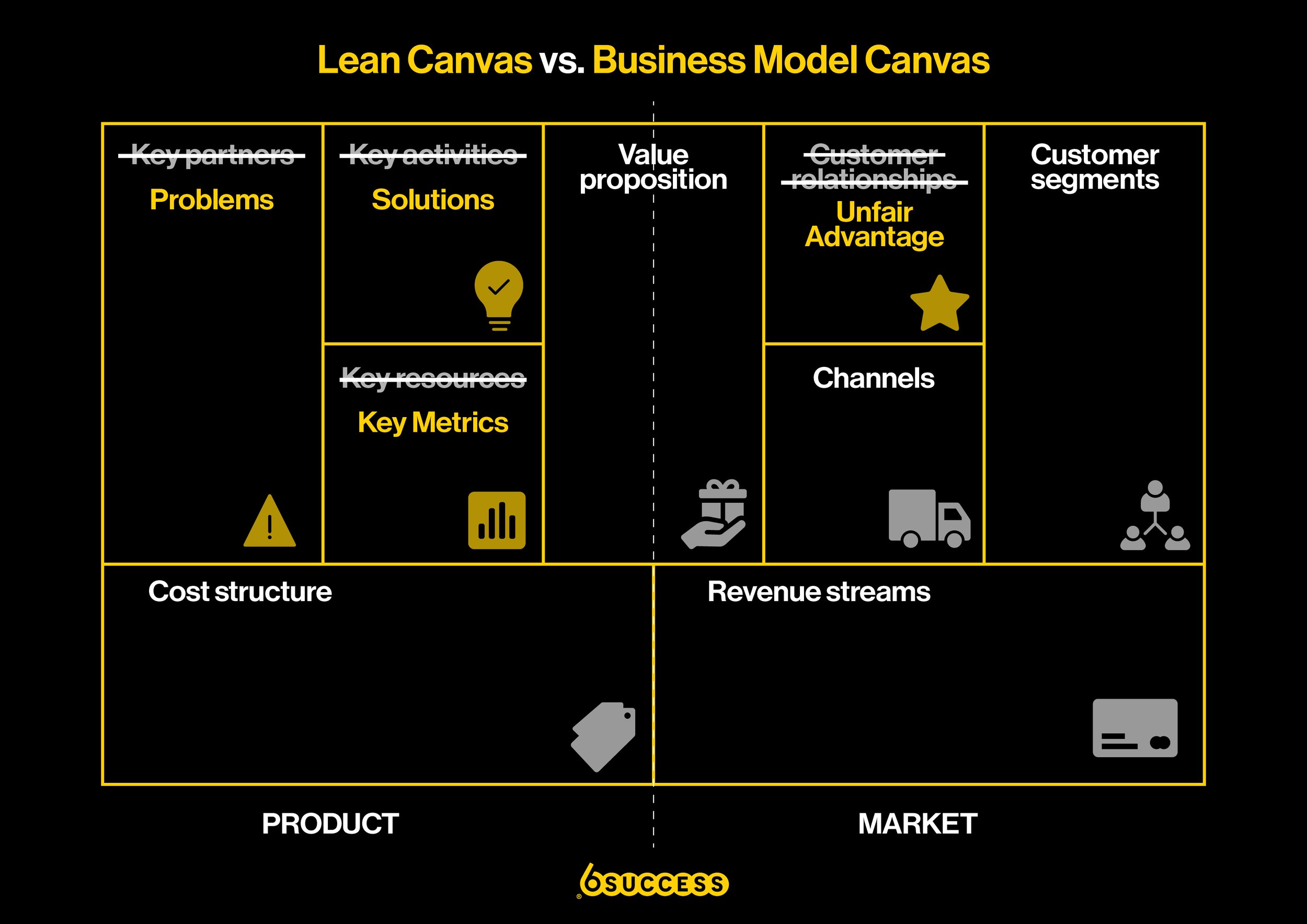What is Lean Canvas?
Lean Canvas | 6success.com
When you want to build a business from scratch, it is not uncommon to be in over your head. This can lead to mistakes, disappointment, stress and unnecessary re-work - all of which can waste your time and money. The Lean Canvas can be used by startups, entrepreneurs, and innovators in any industry. It can be used at all stages of the startup lifecycle from idea generation to scaling a company. The lean canvas is a simple yet powerful tool for startups. It is used to organize your thoughts, generate more ideas and make important decision early on. The format is ideal for keeping track of your startup's progress.
What is Lean Canvas?
Lean Canvas is a business model development tool. It is used to help entrepreneurs and small businesses design and build their businesses. It is often referred to as a, "Business Plan" or an "Executive Summary" of your business idea. It is used by aspiring entrepreneurs and those who want to get their ideas off the ground quickly. It is used by entrepreneurs for many different things, but most commonly it is used as a way to organize the components of your business idea in a project based format. Therefore, Lean Canvas is a simple yet powerful template that helps you to break down your business idea into its core components, this makes it easier to read and edit.
The Business Model Canvas can be used to emulate the success of businesses, whereas the Lean Canvas is more tailored to fit the needs of small and large businesses alike.
Lean Canvas vs. Business Model Canvas | 6success.com
What’s the difference between Lean Canvas and Business Model Canvas?
The Lean Canvas and the Business Model Canvas are two different tools that can be used to help entrepreneurs develop their businesses. The Lean Canvas is a shorter, simpler tool that is focused on the key elements of a business. The Business Model Canvas is a more detailed tool that includes more information about a business' finances and operations. Which tool you should use depends on your needs and what you are trying to accomplish.
The business model canvas is a blank sheet of paper that has space for a business plan. The business model canvas is perfect for ensuring your business plan is always up-to-date, no matter how early in the development process you are. It includes a series of boxes that you can use to write down the key elements of your business. Nevertheless, when startups which lacked a legit physical presence used the business model canvas, they weren't able to fill all the boxes and the canvas remained partially complete. This is when the Lean Canvas is more required.
The Lean Canvas is a one-page business plan that is used to help simplify and focus on the most important elements of a business. It organizes your ideas in order to ensure you are thinking about the right things at the right time. It still has the same 9 elements that Business Model canvas has, but it has renamed some of them to make it suitable for new startups. The Lean Canvas provides a simple, yet powerful way for entrepreneurs to record the business model of their startup. This tool is constantly updated to ensure that it remains relevant and useful for everyone involved in any industry and any level such as presenting a new idea to the market.
Lean Canvas' problem-solution approach eliminates what's not needed from the business plan, making it useful for startups. Since new startups often have no products to validate market needs, they don't pay much attention to customer section in business model canvas which is considered as its disadvantage.
Comparing Lean Canvas template with the Business Model Canvas, it is clear that four boxes are replaced with new boxes. “Key Partners” and “Key Activities” were replaced with “Problem” and “Solution”, respectively. Moreover, “Key Resources” and “Customer Relationships” were exchanged with “Key Metrics” and “Unfair Advantages”, correspondingly.
Lean Canvas Components | 6success.com
Components of a Lean Canvas
As it is mentioned before, a Lean Canvas has 9 components, which are briefly explained below:
Problem
The problem box in Lean Canvas is designed to help identify and prioritize top three key problems that need to be solved. However, when businesses don't apply the necessary time, effort and resources, the wrong products are built. It's crucial to understand the problem first in order to avoid these mistakes.
Customer Segment
Different customers have different needs, so it's important to create different canvases to attract each type of customer. For example, engineers and accountants have different needs, so it's important to create separate canvases for each type of customer. Problem box and Customer Segment are inextricably linked; you can't think of one without the other.
Unique Value Proposition
The Unique Value Proposition is the heart of the Lean Canvas. It's what makes your product different and why customers should want to buy it. Understanding why your product is unique and why your customer segments should invest in it is the best way to create a compelling UVP.
Solution
The best way to find a solution to a problem is to “Get out the Building” – a famous sentence from the godfather of the Lean Startup, Steve Blanks. For better understanding of customers’ needs, you have to get out there and talk to your customers and ask them questions. This is the reason why the Minimum Viable Product concept is so important - it helps you get feedback from your target market. This allowed for a way to explore different potential solutions and find the best one. By understanding your customers' needs, you can find the best possible solution to the problem.
Key Metric
Startups should focus on one key metric and develop it further. This metric should be based on the range of services or products you offer. It is therefore critical that the right metric is identified in order to avoid devastating consequences for the startup. Every business will have key metrics that are used to monitor performance no matter of its industry or size.
Channels
Reaching your target customer segment can be easier than you think, especially when you use the right channels. It's important to focus on learning about all the different channels available to you, both paid and free, so you can reach your customers directly. Some great examples of channels include social media, trade shows, email, CPC ads, radio and TV, blogs, webinars, and articles. However, you do not need to have them all, just ones you can use to reach to your customers segment.
Cost Structure
Here you can list the entire variable cost, as well as the fixed costs, associated with your project. If you have any questions about the cost structure, this is the place to ask. How much does it cost to build a page? What is the amount required to run your company in a month? And more. By understanding these costs and potential revenue streams, you can calculate a rough break-even point for your project.
Revenue Streams
How you rate your business depends on the model type you choose. In order to attract users, many startups offer freemium mode for their products in the beginning. However, this can delay or even prevent users from verifying the product's validity. In fact, getting people to sign up for something for free is often very unlike from asking them to pay for it.
Unfair Advantage
This box is the hardest box to fill in at the beginning. This is why you should know what is your betterment than others’. Startups should always be on the lookout for an unfair advantage - something that sets them apart from the competition and gives them an edge. This can come in many forms, such as expert endorsements, a dream team, insider information or existing customers.



